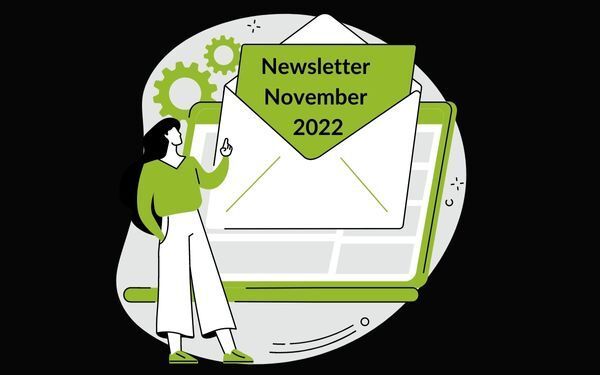8 steps to create a social media strategy for 2023 (+ free social media planner template)

Did you know that 43% of businesses spend 6 or more hours per week on social media? That’s a significant investment of staff time, but if you’re not posting strategically, there’s a risk that time is not being well spent.
Developing and executing a social media strategy will help you to…
• Post consistently;
• Post strategically in a way that meets your goals;
• Build an audience for your content;
• Work more efficiently and more cost-effectively;
• Target your audience more effectively;
• Achieve a better ROI on social media marketing spend; and
• Track your performance so you can assess how well you’re doing.
Here are our eight steps to creating a winning social media strategy for 2023.
1. Set meaningful goals that relate to your business
Many businesses sign up for multiple social media channels and start posting without ever stopping to think about what they want to achieve. Without setting clear goals your content is likely to be inconsistent, purposeless and difficult to evaluate.
The goals you set should help your business to deliver against your key priorities (such as those set out in annual business plans). Buffer sets out some good examples of meaningful business-led goals including:
- Increasing brand awareness.
- Driving traffic to your website.
- Generating new leads.
- Growing revenue (by increasing signups or sales).
We possible we recommend setting S.M.A.R.T goals, that is, goals that are:
- specific;
- measurable;
- attainable;
- relevant; and
- time-bound.
S.M.A.R.T is a recognised framework that’s widely used in business planning. Social media scheduler Hootsuite has a useful guide to applying the S.M.A.R.T. method to social media goals.
2. Identify metrics to help you measure performance
Setting goals is the first part of defining what you want to achieve. To know if you’re successful you will also need to identify meaningful metrics to measure this.
For example, if you have a goal of increasing social media engagement you could use the following metrics:
Activity – How many likes, comments, shares or retweets you get on your content (and if this is increasing). You should find this information in the analytics sections of your social media accounts.
Website acquisitions from social media – Engagement on social media is great, but for most businesses, you’ll need to get customers to your website if you want to make a sale. A metric of the number of website visitors acquired from social media (available in Google Analytics) will identify how many leads you’re generating from social media.
Followers – Whilst not a direct measure of engagement (you can have disengaged followers), if your follower count grows steadily this is a sign that you have a growing rather than shrinking follower base and that users are engaging with your business via social media.
You can have more than one metric per goal, what matters is that the metrics help you judge how close you are to meeting your goal.
Without using metrics you have no way of knowing if the actions you're taking are making a difference. Metrics can tell you if you're reaching your goal but also how effective your investment is, whether you're getting a good return and whether you need to continue, cease or revisit a strategy.
The very act of measuring can be a driver for improvement, by understanding the response to your actions you can strive for even greater change.
3. Get to know your target audience
As well as knowing what you want to achieve, you must understand the target audience for your social media content. Your audience should be the same on social media as it is for your product. If your product is a travel magazine aimed at young couples with disposable income then there is little value in targeting an audience of retirees on social media.
It’s critical to understand your audience so that you can come to know their behaviour – which social media platforms they use, when they’re active online, what type of content they enjoy and what their aspirations are.
One way of getting to know your audience is to create customer personas. These are like a character profile of a typical customer for your product.
To generate the persona, you will need to know things like your target customer’s:
- age;
- gender;
- job and income;
- location; and
- interests and hobbies.
It’s a good idea to develop 2-3 personas and have these people in mind whenever you create content.
We’ve developed some downloadable buyer persona templates to help you identify your audience for your social media strategy.
Download your free buyer persona templates.
4. Identify what your audience needs and deliver it
Once you’ve identified your target persona, you need to make sure that you’re meeting their needs.
A big part of delivering against your audience’s needs is answering these questions:
1. Which social media channels are my customers using?
2. What content performs best with my customers – and which channels does this align with?
Different social media channels will appeal to different target customers. Wordstream has an excellent infographic that summarises some of the key characteristics of the top seven social media platforms. It’s worth a look in detail as there are many takeaways. For instance, if you wanted to know which channel to use to connect with different age groups, you could extrapolate the following:
• 18-24 years: YouTube, Instagram
• 25-34 years: Facebook, Instagram, YouTube, Twitter, Snapchat
• 35-44 years: Twitter, Instagram
• 45-55 years: LinkedIn
• 65+: Facebook
They also identify which strategies work well and which content performs best on each platform. Sprout Social (another source on social media usage by demographic) identifies that the majority of Instagram and TikTok users are Millenials or Gen Z and they favour personality-led, bold videos and posts. In terms of Pinterest, Sprout Social classify the channel as populated primarily by female users.
Statista has also created some really interesting charts of social media usage by different demographics.
There are many sources on social media demographics and we can only highlight a few here. You will need to undertake your own research to find out where the customers you have identified from your personas are to be found and what types of content they relate to.
Responding to the actual needs of your audience may mean closing some social media accounts and joining new channels. It is also likely to mean changing the type of content you post, how often you post and when you post. This may feel like a significant challenge at first. However, if you are serious about getting a better return on your social media marketing spend, this effort will be worth it.
5. Undertake a social media audit
When developing a new social media strategy, it’s important to take a look at what you’ve already been doing. Unless you’re completely new to social media, you will likely have historic posts you can review.
In your audit you should look at how well your historic content and activity:
- delivers against the metrics and goals you have identified;
- meets the needs of your audiences; and
- performs in terms of engagement (use the analytics functions of social media platforms to track likes, follows, shares etc.).
Where you identify high-performing historic content this can become a useful guide to help you create effective new content with a similar appeal.
When completing an audit, it’s important not to neglect competitor analysis. Look at the content your competitors are generating and how it performs with your shared audience.
The audit aims to answer questions like:
- What is working well and what isn’t?
- Who engages with your content?
- How do your social media presence and activity compare to your competitors?
You can complete the audit yourself by going over the recent posts of your social media accounts and that of your main competitors and looking at content type (e.g. video, text, image etc), performance (engagement) and content nature (what is being talked about).
However, if you’re not used to this kind of audit activity it can be difficult to know what to look for and to draw useful conclusions. That’s where we can help. We offer a social media review that includes an audit of your existing social media channels and those of 4-5 of your competitors. You’ll receive a report summarising our findings such as what you’re doing well and what channels are most aligned with your industry. You’ll find plenty of recommendations and suggested actions to help you develop your 2023 social media strategy and to post more effectively going forwards.
6. Develop a social media content strategy building on all you have learnt so far
By this point, you have a good picture of what you want to achieve, who your audience is, what they need and respond to, and what you have done well in the past.
It’s now time to translate that into building a social media content strategy. A content strategy is a high-level statement of intent that sets out:
• What content you want to share (the key messages about your business).
• What content type you want to share (video, text, image, infographic etc).
• Which social media platforms you will share content on.
• When you will share content (times of day and days of the week).
In its simplest form, this could be deciding to post short-form videos about your product features to Facebook and Twitter once a day at lunchtime. However, you will likely want to go into more detail than this with varying messages, content types and times to reach your full audience.
When developing your social media content strategy, it’s important to remember your goals and why you are posting to social media. To ensure you are posting effectively, you should include calls-to-action (CTAs)in all your content that supports your goals. Calls-to-action could include links to buy products from your website, sign-ups for a newsletter mailing list or invitations to share content to grow brand awareness. For more on CTAs, check out 10 tips to create a winning call-to-action.
And, of course, you’ll want to create engaging content that is aligned with your brand and tailored to your audience and the social media platform you’re posting on.
7. Create and execute a social media calendar or plan
Once you’ve decided upon the types of content that you want to share, you’ll want to set out a plan for delivering this. Producing a social media calendar or plan will define exactly which posts or campaigns will be run on which days and on which accounts.
Your plan will go into a more granular level of detail than your social media strategy and is a blueprint for delivery. Ideally, it should be clear enough that if your social media manager were absent for any reason, other team members could pick up the plan and know what to post.
Setting out a detailed social media plan also means that you can schedule content using a platform like Hootsuite, Later or Buffer. This can help to make staff time spent on social media more effective by blocking social media activity into regular chunks (rather than needing to post daily). It also helps to ensure social media activity continues during periods of staff leave or absence.
To help with planning your social media campaigns we’ve developed a social media campaign and content planner.
The free planner will help you to:
• Have oversight of all your current social media campaigns in one place.
• Plan when you’ll post on each social media platform.
• Organise links, images, videos and other content.
• Plan your social media across Facebook, Instagram, YouTube, Twitter, LinkedIn, Pinterest and more.
Download your free Social Media and Content Planner
8. Evaluate your social media strategy regularly and refine it where needed
Too often, we get so caught up in delivery that we fail to evaluate. It’s important to set regular evaluation points in your calendar to assess how your 2023 social media strategy is working.
By referring back to your goals and metrics you can see where you are meeting these and where further work is required. Undertaking audits of your new content will also help you to understand what is working well with your audiences.
A natural follow on from evaluation is refinement. Once you know what is and isn’t working well in your current strategy, you can refine it to make further improvements.
Final tips on creating and implementing a social media strategy for 2023
1. Social media is responsive and you need to be too. Planning your social media activity has many advantages, however, you still need to be engaged in the here and now. This means being able to react quickly and responsively to opportunities as they arise (i.e. engaging on topical news stories, new trends in content creation etc). You should also be sensitive to major events that could change how your planned content is seen. For instance, events like natural disasters, wars, celebrity deaths, recession/economic hardship and political unrest may mean that previously planned social media content becomes inappropriate and may need to be postponed or cancelled.
2. Let your blogging and content creation strategies inform your social media strategy. Social media and blogging go hand in hand. Much social media content is generated from sharing links to news pieces, blog posts and company updates. So, it’s a good idea to consider your social media strategy as part of your wider content creation strategy.
3. Make sure you keep up-to-date with changing social media trends. Social media changes rapidly and you’ll need to know the latest features and capabilities of social media channels and also current trends in content creation. A great resource for this is HubSpot’s annual Marketing Strategy & Trends Report. This contains sections on the top social media marketing channels, which media formats marketers are using, common marketing goals and much more. Check out the 2023 Marketing Strategy & Trends Report.
Get help to develop and implement a social media strategy
Sometimes it helps to get a new perspective on your business. When it comes to self-evaluation it can be difficult to address where things aren’t working well. And there’s no denying that developing an effective social media strategy takes time. If you’re struggling with your social media then QuayClick can help.
We’re experienced in developing social media strategies for businesses in different sectors and industries. We’ll look at your current activity, and your goals and develop a strategy that works for you. We can help with social media content creation and social media management and can explore if you’d benefit from advertising on social media. For more information, or to discuss your business’ social media goals, , please contact us.




QUICK LINKS
QC Newsletter sign-up
We will get back to you as soon as possible.
Please try again later.
All Rights Reserved | QuayClick Marketing Ltd
We’re a website design and digital marketing agency based in Exeter. We help businesses grow online and have over 20 years of experience in Web Design. We offer several inbound strategies, including paid search and SEO. In addition, our content team can help with copywriting and email campaigns.











